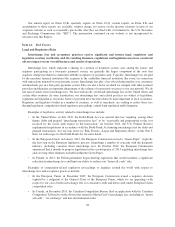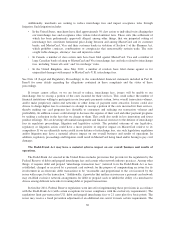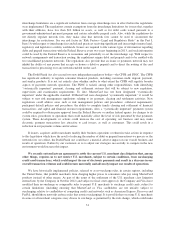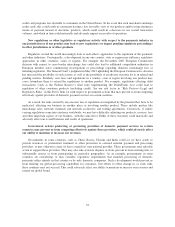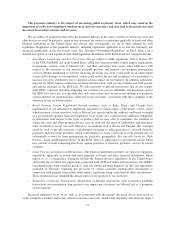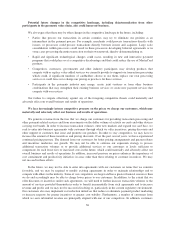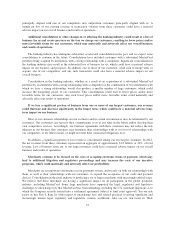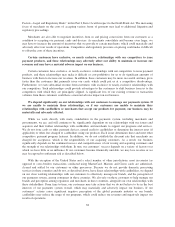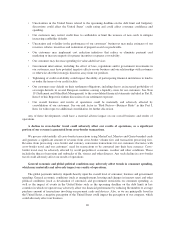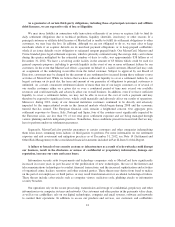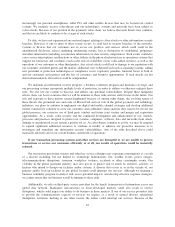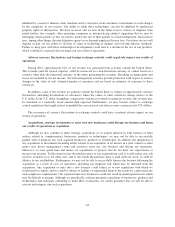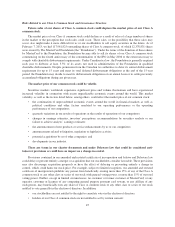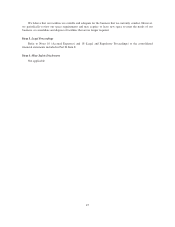MasterCard 2012 Annual Report Download - page 42
Download and view the complete annual report
Please find page 42 of the 2012 MasterCard annual report below. You can navigate through the pages in the report by either clicking on the pages listed below, or by using the keyword search tool below to find specific information within the annual report.Factors—Legal and Regulatory Risks” in this Part I, Item 1A with respect to the Dodd-Frank Act. The increasing
focus of merchants on the costs of accepting various forms of payment may lead to additional litigation and
regulatory proceedings.
Merchants are also able to negotiate incentives from us and pricing concessions from our customers as a
condition to accepting our payment cards and devices. As merchants consolidate and become even larger, we
may have to increase the amount of incentives that we provide to certain merchants, which could materially and
adversely affect our results of operations. Competitive and regulatory pressures on pricing could make it difficult
to offset the costs of these incentives.
Certain customers have exclusive, or nearly exclusive, relationships with our competitors to issue
payment products, and these relationships may adversely affect our ability to maintain or increase our
revenues and may have a material adverse impact on our business.
Certain customers have exclusive, or nearly-exclusive, relationships with our competitors to issue payment
products, and these relationships may make it difficult or cost-prohibitive for us to do significant amounts of
business with them to increase our revenues. In addition, these customers may be more successful and may grow
faster than the customers that primarily issue our cards, which could put us at a competitive disadvantage.
Furthermore, we earn substantial revenue from customers with exclusive or nearly-exclusive relationships with
our competitors. Such relationships could provide advantages to the customers to shift business from us to the
competitors with which they are principally aligned. A significant loss of our existing revenue or transaction
volumes from these customers could have a material adverse impact on our business.
We depend significantly on our relationships with our customers to manage our payments system. If
we are unable to maintain those relationships, or if our customers are unable to maintain their
relationships with cardholders or merchants that accept our products for payment, our business may be
materially and adversely affected.
While we work directly with many stakeholders in the payments system, including merchants and
governments, we are, and will continue to be, significantly dependent on our relationships with our issuers and
acquirers and their further relationships with cardholders and merchants to support our programs and services.
We do not issue cards or other payment devices, extend credit to cardholders or determine the interest rates (if
applicable) or other fees charged to cardholders using our products. Each issuer determines these and most other
competitive payment program features. In addition, we do not establish the discount rate that merchants are
charged for acceptance, which is the responsibility of our acquiring customers. As a result, our business
significantly depends on the continued success and competitiveness of our issuing and acquiring customers and
the strength of our relationships with them. In turn, our customers’ success depends on a variety of factors over
which we have little or no influence. If our customers become financially unstable, we may lose revenue or we
may be exposed to settlement risk as described below.
With the exception of the United States and a select number of other jurisdictions, most in-country (as
opposed to cross-border) transactions conducted using MasterCard, Maestro and Cirrus cards are authorized,
cleared and settled by our customers or other processors. Because we do not provide domestic processing
services in these countries and do not, as described above, have direct relationships with cardholders, we depend
on our close working relationships with our customers to effectively manage our brands, and the perception of
our payments system, among consumers in these countries. We also rely on these customers to help manage our
brands and perception among regulators and merchants in these countries, alongside our own relationships with
these stakeholders. From time to time, our customers may take actions that we do not believe to be in the best
interests of our payments system overall, which may materially and adversely impact our business. If our
customers’ actions cause significant negative perception of the global payments industry or our brands,
cardholders may reduce the usage of our programs, which could reduce our revenues and negatively impact our
results of operations.
38


